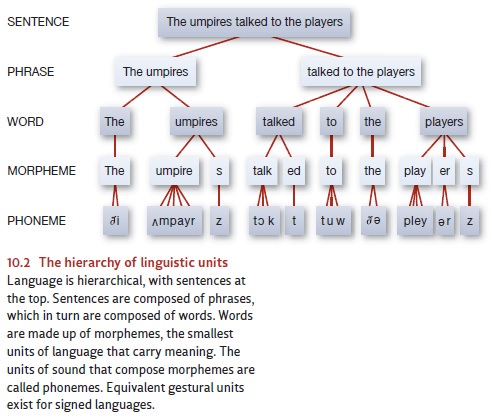Chapter: Psychology: Language
Building Blocks of Language: Morphemes and Words
Morphemes and
Words
At the next level of the
linguistic hierarchy (see Figure 10.2), fixed sequences of phonemes and
syllables are joined together into morphemes. The morphemes are the smallest language units that carry bits of
meaning. Examples of morphemes are talk,
tree, and the -edmorpheme that marks the past tense. Some words consist of a
singlemorpheme, such as and, man, and bake, while others contain more than one, for exam-ple, waterfall, talked, and downstairs.

CONTENT MORPHEMES AND FUNCTION MORPHEMES
Morphemes such as bake and man that carry the main burden of meaning are called content morphemes. The morphemes that
not only add details to the meaning (suchas plurality or tense) but also serve
various grammatical purposes (such as the suffixes -edand -ness and the
connecting words and and which) are calledfunction morphemes.This distinction of morpheme type, existing in
all languages, is reflected in the sound characteristics of the language, so
that content and function morphemes are pro-nounced somewhat differently, with
the function words more likely to be shorter and unstressed (Shi, Morgan, &
Allopenna, 1998). The intermixing of function and content morphemes in
sentences is an important factor giving speech its rhythmic cadence of strong
and weak beats (Nespor, Peña, & Mehler, 2003). Some function morphemes
cannot stand alone and must be joined with others to make up a complex word. We
mentioned -ed; other examples are -er (meaning “one who”) and -s (meaning “more than one”). When these
are joined with the morpheme bake
(meaning “to cook by slow heating”) into the complex word bakers (bake !er!s), the meaning becomes
correspondingly complex (“ones who cook by slow heating”). And once again (just
as with phonemes) there are constraints on where in the sequence each morpheme
occurs. We could not, intelligibly, say erbakes
or bakeser instead of bakers.
Recordings of activity in the
brain reveal that content and function morphemes are processed in different
ways during normal language activities (C. M. Brown, Hagoort, ter Keurs, 1999).
Relatedly, in brain injury a person’s ability to utter or process function
morphemes may be compromised while the content words remain intact (the reverse
condition also occurs, though more rarely), confirming the fact that these two
types of words rely on partly different brain circuits and are sited
differently in the brain.
Related Topics